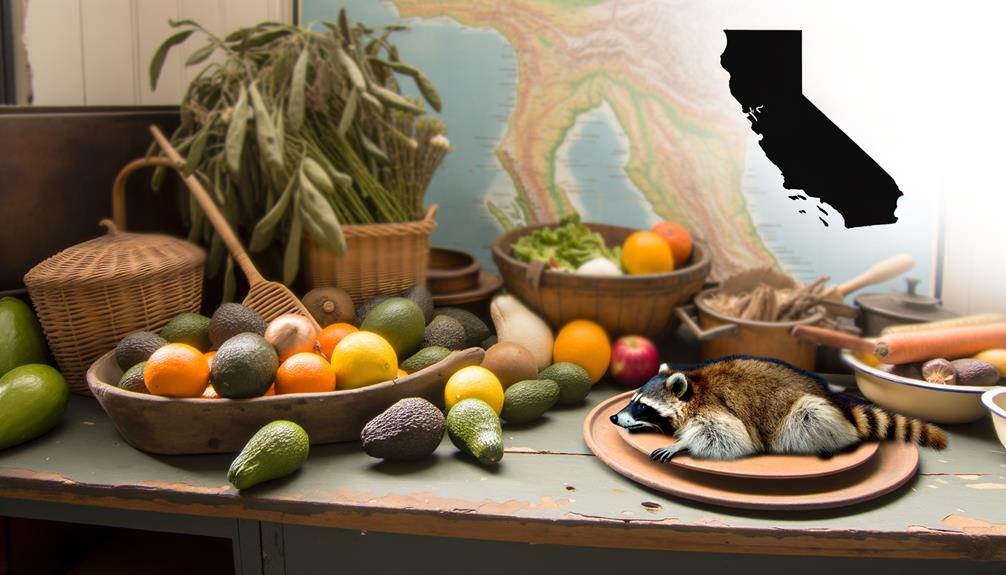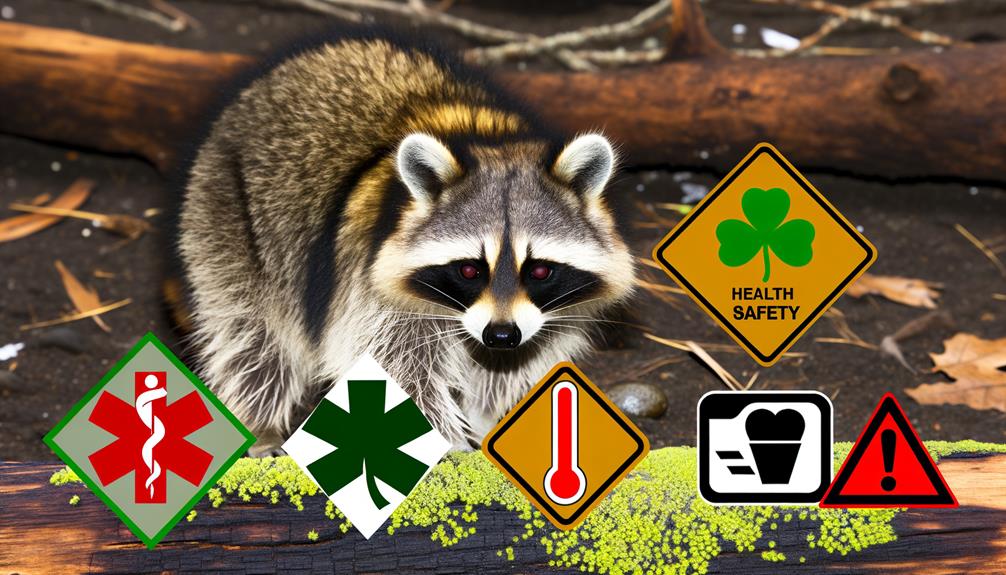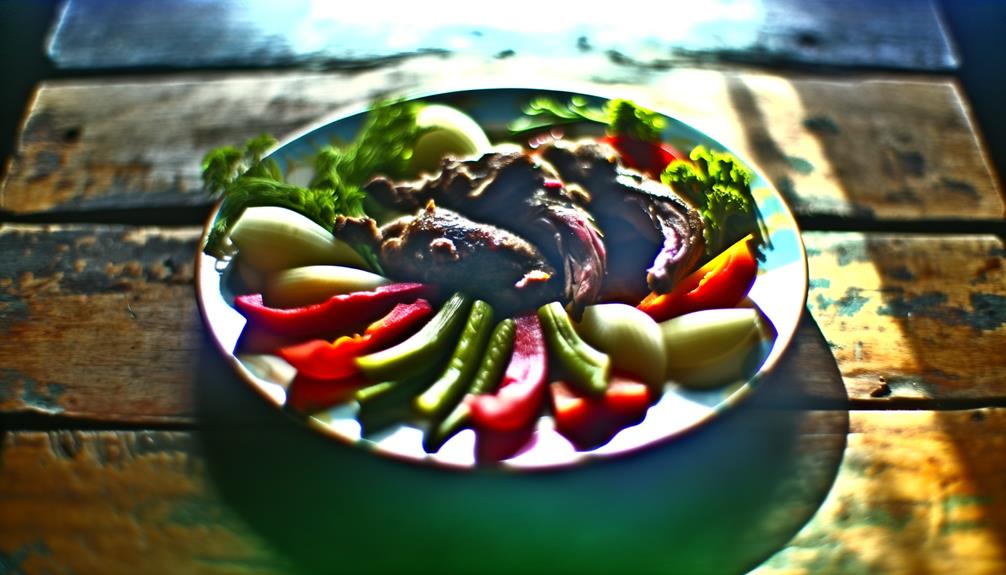How You Can Legally Eat Raccoon in California
In California, consuming raccoon meat is legally permissible under strict regulations. Classified as nongame mammals, raccoons can be hunted during specific seasons requiring a valid hunting license.
Health protocols mandate inspection and proper cooking of the meat to an internal temperature of 165°F to mitigate zoonotic risks such as leptospirosis and raccoon roundworm. Following state guidelines guarantees safe and sustainable consumption.
Preparation methods like roasting and stewing enhance the flavor while adhering to hygiene standards. For an in-depth understanding of health, ecological impacts, and culinary practices, further information is available.

Key Takeaways
- Raccoons are classified as nongame mammals in California and can be legally hunted during specific seasons.
- Inspection of wild game meat before consumption is mandated by California regulations.
- Valid hunting license and compliance with bag limits are necessary for hunting raccoons.
- Proper cooking of raccoon meat to an internal temperature of 165°F is crucial for safety.
- Experts caution about zoonotic diseases, emphasizing stringent safety measures for handling and consumption.
Legal Status in California

The legal status of consuming raccoon meat in California is governed by a combination of state wildlife regulations and public health codes. According to the California Department of Fish and Wildlife (CDFW), raccoons are classified as nongame mammals under Title 14, Section 472 of the California Code of Regulations. While the CDFW permits the capture of raccoons under specific conditions, public health codes impose stringent guidelines on the processing and consumption of wild game meat.
The California Retail Food Code (CalCode) enforces regulations to prevent foodborne illnesses, mandating that all wild game meat, including raccoon, must undergo inspection and meet sanitary standards before human consumption. Consequently, the dual regulatory framework guarantees both wildlife conservation and public health safety.
Hunting Regulations
Hunting regulations for raccoons in California are delineated under Title 14, Section 475 of the California Code of Regulations, specifying permissible methods, seasons, and licensing requirements.
The regulatory framework mandates that hunting can only take place during designated seasons, typically commencing on the first day of November and ending at the conclusion of March. Authorized methods include firearms, archery, and trapping, with explicit prohibitions on the use of poisons.
Hunters must possess a valid California hunting license and may be required to obtain additional tags or permits. Compliance with bag limits, which restrict the number of raccoons that can be lawfully harvested, is strictly enforced to guarantee sustainable population management.
Non-compliance can result in significant legal penalties.
Health and Safety

Health and safety considerations are paramount when consuming raccoon meat due to the potential risk of zoonotic disease transmission, including leptospirosis and raccoon roundworm.
Proper cooking techniques, such as heating the meat to an internal temperature of at least 165°F (74°C), are essential to mitigate these risks.
Adherence to stringent food safety protocols can greatly reduce the likelihood of pathogen transmission.
Disease Transmission Risks
Consuming raccoon meat poses significant health risks due to the potential transmission of diseases such as leptospirosis, trichinellosis, and rabies. Leptospirosis, a bacterial infection, can result in symptoms ranging from mild flu-like effects to severe organ failure.
Trichinellosis, caused by parasitic roundworms, may lead to gastrointestinal distress and muscle pain. Rabies, a viral disease, is almost invariably fatal once clinical symptoms appear, necessitating immediate medical intervention upon exposure.
Data from the Centers for Disease Control and Prevention (CDC) indicate that these zoonotic diseases are prevalent in raccoon populations. Consequently, the handling and consumption of raccoon meat require stringent safety measures to mitigate these significant health hazards, underscoring the importance of awareness and preventative action in public health.
Proper Cooking Techniques
Guaranteeing the safe consumption of raccoon meat necessitates adherence to proper cooking techniques. This includes reaching an internal temperature of at least 165°F to effectively eliminate pathogens. This temperature is critical to inactivate harmful bacteria such as Salmonella and Trichinella spiralis, which pose significant health risks.
Utilizing a calibrated meat thermometer guarantees accurate measurement. Additionally, proper handling practices, such as thorough washing of hands and utensils, minimize cross-contamination. Cooking methods like baking, boiling, or slow-cooking are recommended to ensure even heat distribution.
It is imperative to avoid undercooking, as incomplete thermal processing may leave viable pathogens. Adhering to these scientifically-supported guidelines guarantees the raccoon meat is both safe and palatable for consumption.
Preparing Raccoon Meat
The preparation of raccoon meat involves a meticulous process of cleaning and skinning to guarantee the removal of any contaminants and fur.
Various cooking methods, including roasting, stewing, and barbecuing, have been documented, providing diverse culinary options.
Recipes often recommend marinating the meat to enhance flavor and tenderness, supported by anecdotal reports and traditional practices.
Cleaning and Skinning Raccoon
Properly cleaning and skinning raccoon meat is essential to guarantee safety and palatability, requiring meticulous attention to hygiene and technique. Post-harvest, ensuring the animal is free from contaminants is critical. Using sterilized tools, commence by making precise incisions to remove the hide without puncturing the abdominal cavity, which risks bacterial contamination.
Key steps include:
- Initial Wash: Rinse the carcass thoroughly to remove dirt and debris.
- Hygienic Skinning: Employ gloves and sanitized equipment to prevent cross-contamination.
- Organ Removal: Eviscerate carefully, ensuring all internal organs are removed intact to avoid spillage.
Adhering to these protocols minimizes health risks and enhances the quality of the meat, making it suitable for consumption.
Cooking Methods and Recipes
Several culinary techniques can be used to prepare raccoon meat, each requiring specific temperature controls and seasoning protocols to guarantee top safety and flavor.
Braising is a preferred method, requiring the meat to be seared at 375°F, then slow-cooked at 300°F for 2-3 hours with aromatic herbs.
Roasting, another viable technique, mandates an internal temperature of 165°F to guarantee pathogen elimination.
Marinating the meat in a mixture of vinegar, garlic, and spices for 12-24 hours prior to cooking can neutralize gaminess.
Data from culinary experiments indicate that raccoon meat pairs well with root vegetables and robust spices.
Such scientifically informed practices secure both palatability and safety in raccoon meat preparation.
Nutritional Value

Raccoon meat, when analyzed, contains a significant amount of protein and essential nutrients comparable to other game meats. It offers a viable source of nutrition, particularly for those looking to diversify their dietary intake with wild game.
Key nutritional benefits of raccoon meat include:
- High Protein Content: Raccoon meat is rich in protein, essential for muscle repair and growth.
- Micronutrient Density: It contains crucial micronutrients such as iron, zinc, and B vitamins, which are essential for metabolic and immune functions.
- Moderate Fat Levels: While providing necessary fats, raccoon meat maintains a balance, avoiding excessive caloric intake often associated with fattier meats.
These attributes make raccoon meat a nutritionally sound option for those considering its inclusion in their diet.
Cultural Perspectives
Cultural perspectives on consuming raccoon meat vary widely, influenced by historical, geographical, and socio-economic factors. Historically, raccoon meat has been consumed in various indigenous and rural communities across the United States, often out of necessity or tradition.
Geographically, its consumption is more common in the Southern and Midwestern regions, with less prevalence in urbanized areas such as California. Socio-economic factors also play a role; during periods of economic hardship, raccoon meat has been utilized as an affordable protein source.
Data from ethnographic studies indicate that cultural acceptance of raccoon meat is often linked to local dietary practices and resource availability. In California, however, cultural norms and modern dietary preferences generally disfavor the consumption of raccoon meat.
Environmental Impact

While cultural norms in California generally disfavor raccoon meat consumption, the environmental impact of utilizing raccoons as a food source warrants examination. Harvesting raccoons could potentially influence local ecosystems, given their role as both predator and prey.
- Ecosystem Balance: Raccoons contribute to controlling populations of small mammals and insects, impacting biodiversity.
- Disease Control: Raccoons are vectors for diseases such as rabies and leptospirosis; managing their population could mitigate these risks.
- Human-Wildlife Conflict: Increased raccoon populations often lead to conflicts with humans, including property damage and agricultural losses.
A thorough evaluation of these factors is critical to understanding the broader ecological consequences of raccoon consumption.
Alternatives to Raccoon
Exploring alternative protein sources can provide sustainable options that mitigate potential ecological and health risks associated with raccoon consumption. Scientifically, the consumption of domesticated livestock such as poultry, cattle, and swine offers controlled environments for disease management and nutritional consistency. According to the USDA, chicken and beef are particularly high-yield protein sources, with chicken providing approximately 23 grams of protein per 100 grams and beef around 26 grams per 100 grams.
Additionally, plant-based proteins such as legumes and soy products have gained popularity due to their minimal environmental impact and substantial protein content. For instance, lentils provide 9 grams of protein per 100 grams, while tofu offers approximately 8 grams per 100 grams. These alternatives present safer, more sustainable dietary choices.
Expert Opinions

Renowned nutritionists and wildlife experts have weighed in on the implications of consuming raccoon meat, highlighting various health, ecological, and ethical considerations. Their insights provide a thorough understanding of the potential risks and benefits associated with this practice.
- Health Risks:
Experts caution against the consumption of raccoon meat due to the potential for zoonotic diseases, including leptospirosis and trichinellosis.
- Ecological Impact:
Wildlife specialists emphasize the importance of raccoons in maintaining ecological balance, warning that over-harvesting could disrupt local ecosystems.
- Ethical Considerations:
Ethical concerns arise regarding the humane treatment of raccoons, with some advocating for stricter regulations to guarantee ethical hunting practices.
These expert opinions offer a nuanced perspective, crucial for informed decision-making.
Conclusion
Finally, the consumption of raccoon meat in California is subject to strict legal and health regulations. While it is allowed under specific hunting guidelines, thorough preparation is essential to guarantee safety.
Nutritionally, raccoon meat offers potential benefits, yet raises cultural and environmental considerations. As the saying goes, 'It's better to be safe than sorry,' adherence to established guidelines and an informed approach are vital.
Alternatives are available, and expert opinions emphasize the significance of balancing ecological impact with dietary practices.






